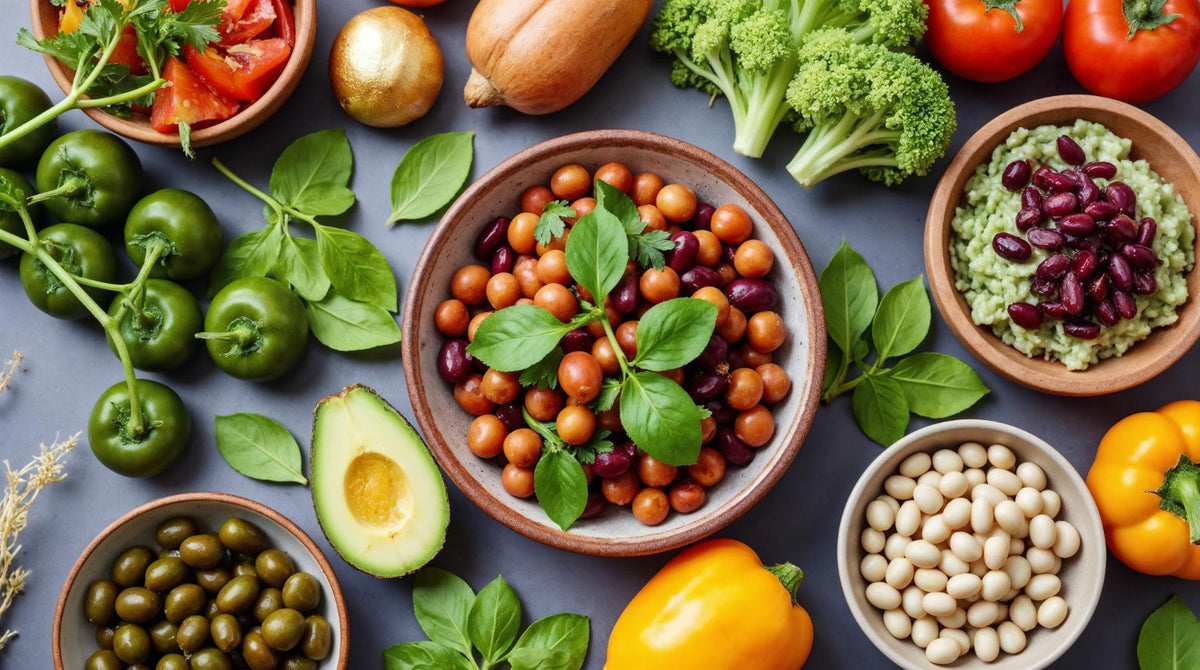Plant Sterols and Cholesterol: How Natural Compounds Block Absorption and Support Heart Health

If your goal is to lower LDL cholesterol naturally, plant sterols are hard to ignore. They’ve been integrated into heart-healthy dietary patterns for decades and are endorsed by major lipid societies as an adjunct to diet and lifestyle. You’ll find them in nuts, seeds, and vegetables—but clinically effective intakes usually rely on fortified foods or supplements. Below, we unpack mechanisms, dosages, timing, safety, and how to combine sterols with other proven levers to improve your lipid profile.
What are plant sterols and stanols?
Plant sterols (phytosterols) and stanols are cholesterol-like molecules found in plants. Common sterols include sitosterol, campesterol, and stigmasterol; stanols are the saturated versions (e.g., sitostanol). Because their chemical structure closely resembles cholesterol, they compete with dietary and biliary cholesterol for incorporation into mixed micelles in the small intestine.
- Origin Naturally present in nuts, seeds, wholegrains, legumes, vegetables, and plant oils.
- Intake reality Typical Australian diets provide ~200–400 mg/day—below the therapeutic range.
- Therapeutic range Most LDL-lowering trials target ~2 g/day sterols/stanols.
How do plant sterols lower LDL?

The way plant sterols and stanols lower cholesterol is a model of biochemical precision wrapped in natural simplicity. Within the small intestine, these plant-based compounds directly compete with both dietary and biliary cholesterol for a seat inside tiny emulsifying droplets known as micelles. These micelles act as molecular ferries, carrying fat and cholesterol through the watery intestinal environment toward absorption. Because sterols and stanols resemble cholesterol structurally but are absorbed poorly themselves, they displace genuine cholesterol molecules from the micelles. As a result, fewer cholesterol molecules are available to cross the intestinal wall.
This competitive exclusion decreases cholesterol transport through the Niemann-Pick C1-Like 1 (NPC1L1) protein — the same intestinal gateway blocked by the cholesterol-lowering drug ezetimibe. When less cholesterol is absorbed, the liver receives a smaller supply. In response, it compensates by producing more LDL receptors, which actively remove LDL particles from the bloodstream to maintain balance. The end result is a steady and clinically significant decline in circulating LDL cholesterol (LDL-C), typically in the range of 8–12 % with daily intakes around two grams.
The effect of sterols doesn’t occur in isolation. They work best when integrated into broader, evidence-based nutrition strategies. Pairing sterols with soluble fibre enhances cholesterol excretion by binding bile acids, while omega-3 fatty acids and energy moderation help reduce hepatic production of very low–density lipoproteins (VLDL). Together, these interventions tackle three metabolic fronts — intestinal absorption, hepatic synthesis, and systemic clearance — offering a complementary, non-pharmaceutical foundation for long-term cardiovascular health.
Clinical evidence & dose–response
Across multiple meta-analyses, ~2 g/day of plant sterols/stanols lowers LDL-C by roughly 8–12% on average. Benefits plateau beyond ~3 g/day in most datasets. Effects are generally consistent across age and baseline LDL levels, though absolute reductions tend to be larger with higher starting LDL-C. HDL-C and triglycerides usually change little.
- Magnitude ~8–12% LDL-C reduction at ~2 g/day.
- Time course Noticeable by 2–4 weeks; reassess at 8–12 weeks.
- Ceiling Diminishing returns above ~3 g/day.
- Consistency Works best when taken with main meals containing fat.
Food sources & fortified options in Australia
Natural foods contribute important baseline sterols, but reaching therapeutic intakes typically requires fortified foods or supplements. In Australia you’ll commonly see sterol-enriched spreads and dairy alternatives.
| Form | Typical sterols per serve | LDL impact (when used daily) | Notes (AU availability) |
|---|---|---|---|
| Sterol-enriched spread | ~1–2 g per 2–3 tsp | ~8–12% with 2 g/day | Common in supermarkets; use on toast/sandwiches with meals. |
| Sterol-enriched milk/yoghurt | ~1–2 g per serving (product-dependent) | ~8–12% with 2 g/day | Check nutrition panels; pair with breakfast. |
| Capsules / chewables | ~0.5–2 g per daily dose | ~8–12% with 2 g/day | Reliable dosing; take with main meals containing fat. |
| Whole foods (nuts, seeds, legumes) | ~0.2–0.4 g/day typical intake | Supportive, usually sub-therapeutic alone | Great foundation; combine with enriched foods or supplements. |
Supplements vs food: which is better?
Both delivery routes work effectively — the best choice depends on your lifestyle and consistency. Fortified foods such as sterol-enriched spreads, yoghurts, and milks allow the dose to be spread naturally across meals, improving absorption and habit adherence. Capsules or chewables provide precise dosing and convenience, especially when travelling or maintaining strict intake targets.
Because sterols act locally in the gut, absorption efficiency relies heavily on timing and context. Always take them with meals that contain some fat, never on an empty stomach. The presence of dietary fat helps micelle formation — the key process through which sterols compete with cholesterol for uptake in the intestine.
- Compliance Choose the format you’ll actually use every day for 8–12 weeks; consistency matters more than form.
- Quality Select products that clearly state sterol or stanol content per serve and list total daily yield.
- Regulatory In Australia, many sterol-enriched products are listed as AUST L on the ARTG and must comply with TGA manufacturing standards.
- Synergy Combine with fibre-rich foods (oats, psyllium, guar) for added LDL-lowering effect and better digestive tolerance.
- Practical tip If using both fortified foods and supplements, track total intake to stay near ~2 g/day — more isn’t necessarily better.
Ultimately, whether you spread sterols over meals through foods or prefer the simplicity of capsules, the goal is steady daily exposure. When used correctly, both formats yield similar improvements in LDL-C reduction and cardiovascular risk markers.
Who benefits most—and how to use sterols in a plan
Sterols are a first-line dietary adjunct for people with raised LDL-C who prefer non-drug options or need extra LDL reduction alongside lifestyle change. They layer well with soluble fibre (e.g., oats, psyllium, guar gum), weight loss where appropriate, and cardio-metabolic habits (exercise, sleep, stress control). For moderate–high risk patients or those not at target, sterols may complement—not replace—medications prescribed by a clinician.
- Borderline to moderately elevated LDL-C.
- Vegetarian/plant-forward eaters.
- People seeking drug-sparing reductions before re-testing.
- Split doses across 2–3 meals.
- Re-check lipids at 8–12 weeks.
- Keep using if results meet your targets.
Safety, side effects & interactions
Plant sterols/stanols are well-tolerated. Minor GI symptoms can occur initially. Because sterols slightly reduce intestinal absorption of fat-soluble carotenoids (e.g., beta-carotene), increase your intake of colourful fruits/vegetables to compensate. People with phytosterolemia (a rare genetic disorder) should not use sterol products. If you are on lipid-lowering medications, discuss sterols with your clinician to align dosing and re-test timing.
How to take plant sterols for results
- Dose Target ~2 g/day total sterols/stanols.
- Timing Take with meals containing some fat (e.g., breakfast spread, lunch, dinner).
- Consistency Daily for 8–12 weeks before reassessment.
- Stacking Combine with soluble fibre (oats/psyllium/guar), weight management, and exercise.
- Monitoring Re-check a fasting lipid panel; track ApoB if available.
Where sterols fit vs other LDL-lowering strategies
| Strategy | Mechanism | Typical LDL-C change | Best use |
|---|---|---|---|
| Plant sterols/stanols (~2 g/day) | Blocks intestinal cholesterol absorption; ↑ LDL receptors | ~8–12% | Adjunct to diet; non-drug option; stack with fibre |
| Soluble fibre (e.g., oats/psyllium/guar) | Bile acid sequestration; microbiome-mediated effects | ~5–10% (at adequate doses) | Foundational daily habit; also improves glycaemia |
| Weight loss (where indicated) | ↓ hepatic VLDL output; metabolic improvements | Variable; often meaningful | Overweight/obesity; broad cardio-metabolic benefits |
| Statins / ezetimibe* | ↓ synthesis (statins); ↓ absorption (ezetimibe) | 20–60%+ (drug-dependent) | Moderate–high risk or not at target with lifestyle |
*Medication use is clinical-decision-based. Dietary sterols can still be used adjunctively—coordinate with your clinician.
Further reading & how sterols integrate
For a complete plan that layers fibre, movement, weight management, omega-3s, and evidence-based supplements, read our pillar: How to Lower Cholesterol Naturally: Evidence-Based Lifestyle & Supplement Strategies.
Plant sterols: frequently asked questions
What are plant sterols and stanols?
They’re cholesterol-like molecules from plants that compete with cholesterol during absorption, reducing the amount that enters the bloodstream.
How much plant sterol do I need each day?
Most trials target ~2 g/day, split with meals. Above ~3 g/day produces diminishing returns.
How quickly do sterols lower LDL cholesterol?
Initial changes can appear by 2–4 weeks, with clearer results by ~8–12 weeks of daily use.
Do plant sterols work as well as statins?
No—medications typically reduce LDL-C more. Sterols are best as an adjunct for mild–moderate elevations or for people optimising diet first.
Can I get enough sterols from food alone?
Typical diets supply ~0.2–0.4 g/day. Therapeutic intakes (~2 g/day) usually require fortified foods or supplements.
Are there side effects?
They’re generally well-tolerated. Mild GI symptoms can occur. Increase colourful vegetables to offset small reductions in carotenoid absorption.
Who should avoid plant sterols?
People with phytosterolemia should not use them. Consult your clinician if pregnant, breastfeeding, or on lipid-lowering medication.
Do sterols lower triglycerides?
Effects on triglycerides are minimal. Combine with omega-3s and lifestyle strategies if triglycerides are elevated.
When should I take plant sterols?
With meals that contain some fat—this improves micelle formation and the competitive effect.
How do sterols fit with fibre and weight loss?
Sterols reduce absorption; fibre binds bile acids; weight loss can reduce hepatic VLDL output. Together, they address multiple lipid pathways.
About this article
- LDL-cholesterol-lowering effect of plant sterols and stanols across different dose ranges: a meta-analysis of randomised controlled studies — Cambridge University Press (Apr 2014)
- LDL-Cholesterol Lowering of Plant Sterols and Stanols—Which Factors Influence Their Efficacy? — Nutrients (MDPI) (Sep 2018)
-
14 October 2025Notes:Article published


